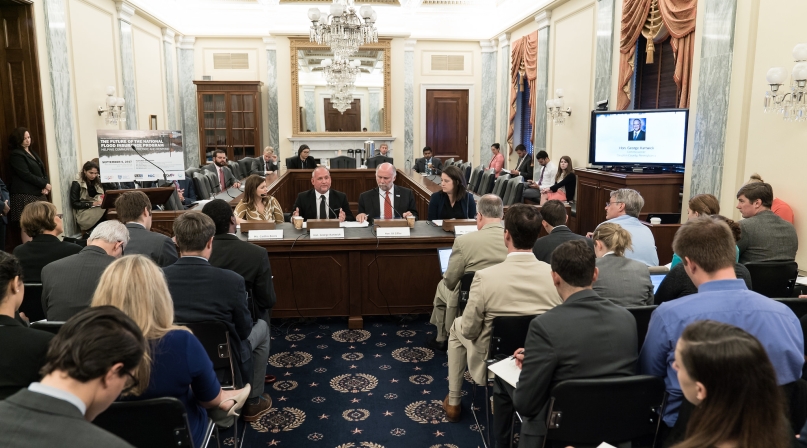Coalition urges reauthorization, fixes to national flood insurance at Capitol Hill briefing

George Hartwick: Potential loss in assessments from NFIP expiration may be biggest impact to local government revenue generation
As Florida, Texas and Louisiana recover from devastating flooding from back-to-back monster hurricanes Irma and Harvey, the importance of reauthorizing and updating the National Flood Insurance Program (NFIP) was made clear Sept. 6 at a Capitol Hill briefing hosted by a coalition led by NACo.
Learn More
A short-term fix for the program, scheduled to expire Sept. 30, took place two days later, when President Donald Trump signed authorization extending the NFIP for three months, through Dec. 8; HR 601 provides an additional $15.25 billion in emergency appropriations for disaster relief.
“This is an issue that impacts everyone,” Dauphin County, Pa. Commissioner George Hartwick said Wednesday. “There may not be a single larger potential impact to the ability to raise local government revenues than the potential loss in assessments if we don’t get this solution correct.”
Counties in Texas could see their property tax revenues sink after the devastation of Hurricane Harvey.
“This is something that is going to depress revenues, the only major revenues our counties have, immediately and for years,” Donald Lee, executive director of the Texas Conference of Urban Counties, a nonprofit organization of 37 member counties, told the Reuters news agency. The Lone Star State is one of seven states across the country that has no state income tax, making it especially dependent on property taxes. Florida, which likewise has no state income tax, could face a similar challenge after picking up the pieces from Hurricane Irma.
NACo hosted “The Future of the National Flood Insurance Program: Helping Communities Prepare and Respond,” along with the National Governors Association (NGA), the National League of Cities (NLC), the Council of State Governments (CSG), the National Association of Insurance Commissioners (NAIC) and the Coalition for Sustainable Flood Insurance.
“It’s very timely that we have this briefing — obviously, our hearts and prayers go out to those impacted by Hurricane Harvey as well as those preparing for Hurricane Irma,” said NACo Executive Director Matt Chase.
As Congress works to reauthorize NFIP, it’s important that there is a balance between the sustainability of NFIP and keeping it affordable to taxpayers, Chase said. NACo’s key policies related to the flood insurance program are focused on rates for policy holders, the program’s administration, flood zone mapping and mitigation.
The median annual premium for residential coverage under an NFIP policy in effect on Aug. 31, 2016, was $520, according to the Congressional Budget Office. Those premiums varied significantly, however. The central two-thirds’ range of the payments for such policies was $420 to $1,330.
In addition to urging Congress to reauthorize NFIP, Hartwick and three other speakers at the briefing also presented their suggestions for improving the program, including keeping flood insurance affordable, strengthening the federal, state and local partnership before and after disasters, updating flood maps and funding pre-disaster mitigation.
The issue hits home for Hartwick, who recalled the devastating impact that Hurricane Agnes had when it flooded his hometown of Steelton, Pa. in 1972. Hartwick keeps a photo of himself sitting on his father’s shoulders after the storm, all of the homes and businesses underwater in the background except for a steel mill that gave the town its name. In 2011, he also saw firsthand the flooding brought by Tropical Storm Lee, after it dropped more than a foot of rain on the county, claiming six lives and leaving more than $200 million in uninsured losses.
Mitigation, mapping, affordability and program participation are key as Congress reauthorizes the program, said Caitlin Berni, vice president for policy and communications at Greater New Orleans, Inc., who also directs its Coalition for Sustainable Flood Insurance.
Tallahassee, Fla. Mayor Pro-Tempore Gil Ziffer said NLC “is asking Congress to do three things, and I’m adding a fourth.” Ziffer said he hopes to see the flood mapping system updated. “Cities and counties need to be engaged in that, we know how to do that,” he said. “You’ve got to redo mapping.”
Jessica Altman, acting Pennsylvania insurance commissioner, said NAIC hopes to see strategies aimed at educating consumers about their options when it comes to flood insurance. NAIC also encourages greater growth in the private flood insurance market as a complement to the NFIP to help provide consumers with more choices, she said.
Jason Tuber, senior adviser to Sen. Bob Menendez (D-N.J.), said legislation sponsored by the senator, whose state was devastated by Superstorm Sandy in 2012, was created with the goal of making the program more solvent, affordable and fair. The so-named Sustainable, Affordable, Fair and Efficient (SAFE) National Flood Insurance Program Reauthorization Act of 2017 would extend the NFIP for six years. The legislation was introduced in June and awaits committee action.
Attachments
Related News

FEMA delays $11 billion in state disaster reimbursements
The Federal Emergency Management Agency (FEMA) recently withheld roughly $11 billion in planned disaster reimbursements to 45 states, shifting the payments to fiscal year 2026 and marking a major change in how the federal government is managing disaster relief funding.

County Countdown – September 22, 2025
Every other week, NACo's County Countdown reviews top federal policy advocacy items with an eye towards counties and the intergovernmental partnership. This week features a short-term funding bill introduced to avert shutdown, new Rural Health Transformation Program and more.

County Countdown – September 9, 2025
Every other week, NACo's County Countdown reviews top federal policy advocacy items with an eye towards counties and the intergovernmental partnership. This week features FEMA reform bill advancement, a major reorganization of the USDA and more.
